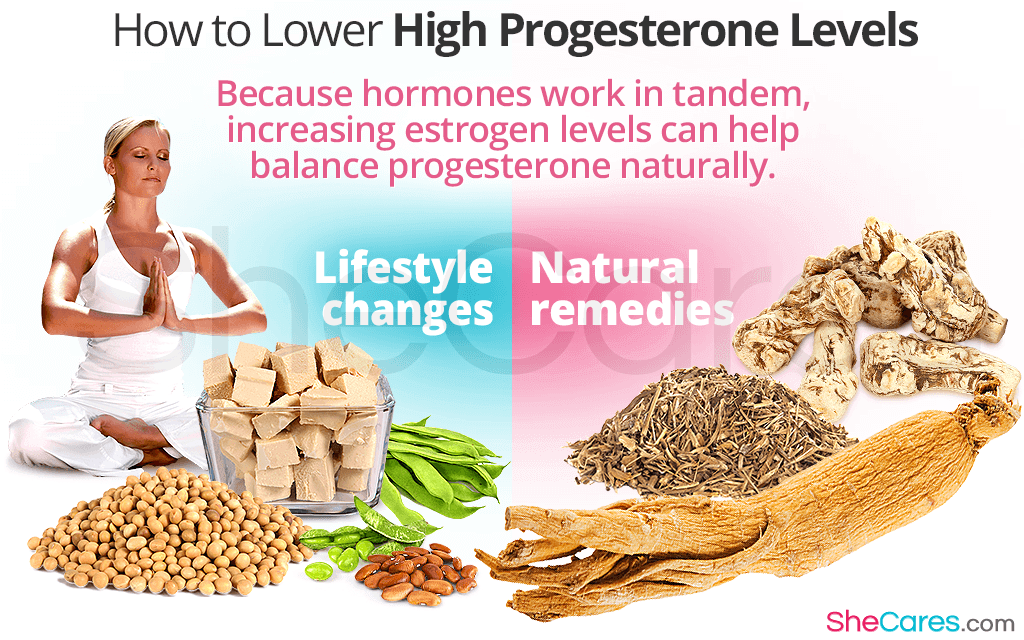While certain degree of hormonal fluctuations, especially of estrogen and progesterone, is normal and expected throughout a woman's life, persistently high progesterone levels can bring about various symptoms, requiring prompt attention. Fortunately, women seeking hormonal balance have numerous options at their disposal.
Keep on reading to learn how to lower high progesterone levels, ranging from lifestyle changes, alternative medicine, and medications, and enjoy long-lasting equilibrium at last!
About High Progesterone Levels
During the menstrual cycle, progesterone levels naturally fluctuate from 0.1 to 25 ng/mL and are known to reach their highest levels during pregnancy.1
Although uncommon, high progesterone levels outside of pregnancy can sometimes occur as a result of smoking, unhealthy eating habits, excessive caffeine consumption, oral contraceptives, hormone replacement therapy (HRT), or medical conditions, like ovarian tumors.
While increased progesterone does not usually trigger negative effects in the body, among the possible symptoms of high progesterone levels are weight gain, mood swings, vaginal dryness, bloating, loss of libido, and more.
So, How do You Lower Progesterone Levels?
Because estrogen and progesterone work in tandem, how to lower high progesterone levels often consists of increasing estrogen levels to achieve long-lasting equilibrium. This can be done with the following approaches:
Dietary Adjustments
Eating a nutritious diet can go a long way in promoting proper balance of reproductive hormones. Alongside complex carbs, lean protein, and healthy fats, women are advised to opt for phytoestrogenic foods, like flax, soy, or tomatoes, which contain compounds with estrogenic activity. By occupying empty estrogen receptors, they help raise the hormone's levels and promote overall balance.2
Regular Exercise
Staying physically active for 150 minutes per week is one of the best ways to deal with high progesterone levels.3 Moderate exercise has been shown to decrease cortisol levels (the stress hormone known to disrupt hormonal equilibrium) and boost estrogen, thus promoting a healthy balance with progesterone and relieving symptoms of an imbalance.4
Wholesome Habits
Since smoking and excessive caffeine consumption are known risk factors for high progesterone levels, controlling these unhealthy habits is likely to bring beneficial results by normalizing adrenal activity.5 Partaking in stress-relief practices, like meditation or deep breathing, is also a good approach to eliminating excess cortisol and restoring hormonal balance.
Herbal Supplements
Herbal supplements are another safe way to lower progesterone levels naturally.6 They include phytoestrogenic supplements, like red clover, which contain higher concentrations of phytoestrogens that work to promote hormonal balance, as well as hormone-regulating supplements, like Macafem, which support the body's own hormone production by nourishing the endocrine glands without the need to introduce outside hormones.
Medications
Depending on a woman's medical status, she may be advised to consider pharmacological options for dealing with high progesterone levels. While a number of treatments, such as birth control pills or HRT, can effectively balance hormones, they should be used with caution to lower the risk of potentially dangerous side effects.
Conclusions
While the effects of high progesterone levels are not as potentially serious as those of low progesterone levels, a prolonged state of hormonal imbalance can turn into a long-lasting deficiency and wreak havoc in a woman's body until promptly resolved. Click on the following link to explore some of the most effective hormonal imbalance treatments that will help you regain control over your hormonal health today!
Sources
- Hormone Health Network. (2019). Progesterone and Progestins. Retrieved January 6, 2020 from https://www.hormone.org/your-health-and-hormones/glands-and-hormones-a-to-z/hormones/progesterone
- Journal of Applied Physiology. (2011). Exercise lowers estrogen and progesterone levels in premenopausal women at high risk of breast cancer. Retrieved January 6, 2020 from https://www.ncbi.nlm.nih.gov/pubmed/21903887
- Medline Plus. (2018). Progesterone Test. Retrieved January 6, 2020 from https://medlineplus.gov/lab-tests/progesterone-test/
- Society for Endocrinology. (2018). Progesterone. Retrieved January 6, 2020 from https://www.yourhormones.info/hormones/progesterone/
Footnotes:
- University of Rochester. (n.d.). Progesterone. Retrieved January 6, 2020 from https://www.urmc.rochester.edu/encyclopedia/content.aspx?ContentTypeID=167&ContentID=progesterone
- Frontiers in Neuroendocrinology. (2010). The pros and cons of phytoestrogens. Retrieved N January 6, 2020 from https://www.ncbi.nlm.nih.gov/pmc/articles/PMC3074428/
- American Heart Association. (2018). Recommendations for Physical Activity in Adults and Kids. Retrieved January 6, 2020 from https://www.heart.org/en/healthy-living/fitness/fitness-basics/aha-recs-for-physical-activity-in-adults
- Piedmont Health. (n.d.). How exercise helps balance hormones. Retrieved January 6, 2020 from https://www.piedmont.org/living-better/how-exercise-helps-balance-hormones
- American Public Health Association. (2009). Smoking Affects Women's Sex Hormone-Regulated Body Form. Retrieved January 6, 2020 from https://www.ncbi.nlm.nih.gov/pmc/articles/PMC2707474/
- Menopause. (2015). Use and perceived efficacy of complementary and alternative medicines after discontinuation of hormone therapy: a nested United Kingdom Collaborative Trial of Ovarian Cancer Screening cohort study. Retrieved January 6, 2020 from https://www.ncbi.nlm.nih.gov/pmc/articles/PMC4470524/



